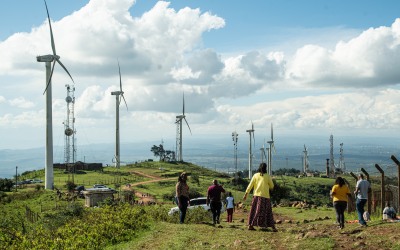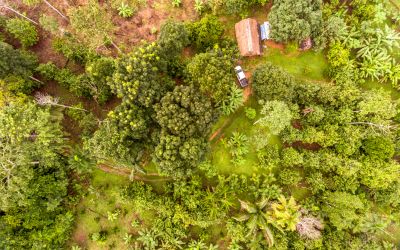Zack Parisa on how SilviaTerra uses data to improve transparency in nature-based climate solutions
Climate Action caught up with Zack Parisa, CEO at SilviaTerra, to discuss how SilviaTerra uses data to improve access, transparency, and credibility in nature-based climate solutions.

Hi Zack, great to have you join us for this interview session.
You join us for the final day of the Sustainable Innovation Forum 2020 where we discussed the role of Data to drive forward this idea of nature-based solutions. Can you tell our readers a bit more about SilviaTerra and how you are using data to build a better understanding about forestry management and carbon credit mechanisms?
At SilviaTerra, our goal is to measure and pay for every value that forests provide, on every acre, every year.
SilviaTerra’s background is as experts in forest measurements. We've spent the past decade using remote sensing and machine learning to improve forest management across the US, providing cost-efficient and high-resolution forest inventories to some of America's largest landowners, conservation groups, and state and federal agencies. The US Forest Service awarded SilviaTerra a sole-source contract for using our data to inform nationwide forest pest and pathogen modeling.
But we wanted to use these measurements to improve nature-based solutions, and to scale them up over millions of acres. So in 2018, we partnered with Microsoft's AI for Earth program to create Basemap, the first ever comprehensive forest map of the US, covering every acre of the contiguous US and accounting for almost 92 billion trees. This dataset underpins the Natural Capital Exchange (NCAPX), our new market for forest carbon.
NCAPX democratizes access to forest carbon markets. By using annually updated, acre-level data, we can work with landowners of all sizes, connect corporate buyers with the lowest-cost carbon on the landscape, and generate a supply of carbon credits that is unprecedented in quality, transparency, and scale.
We have experienced big net-zero commitments over the past few years from companies in every sector. Whilst this is obviously welcomed, there seems to be a reliance on offsetting and forest carbon projects have become a popular pathway. How do you think this will play out in the long term? Do you think the current approach is working?
Great question - forest carbon will be a critical area for both voluntary and compliance carbon markets as they continue to scale.
For net-zero commitments, the first step is of course to reduce emissions. Still, offsets will be an important part of the transition to a decarbonized economy - so it’s crucial that they’re done right.
The issue is that forest carbon projects are regulated by old standards that don’t reflect our current technological capacity. Using new technology, we can produce acre-level data on forests and measure the actual increase in carbon resulting from these projects. Instead of relying on decades-long agreements, we can and should design projects that have measurable results and that pay for real, additional outcomes.
In the future, I see the market evolving to adopt more accurate, less expensive approaches to measuring and monitoring, allowing forest carbon to work at scale. Forests are one of the most cost-effective, shovel-ready climate solutions we have. But to ensure that we’re making real progress towards net zero goals, we have to be willing to update our approach.
So the short answer is no, the current system is not working. The good news is that we have the tools to improve it.
So it seems as though the current approach might not be working as well as it could.
Having reliable data to inform climate-smart decisions will be critical over the next 10 years. As your motto is “measurements make markets”, how will this change the way we see our natural world, our natural capital?
You’re absolutely right about the role of reliable data - and we need high-quality, cost-efficient data in a number of areas. We need measurements of the stocks of natural capital - how much carbon or how much habitat is on the landscape - but we also need economic data to understand how actors on the ground are making decisions about forest management. Without this, it’s impossible to pay for real change.
In addition, our belief is that the data alone isn’t enough. We also need efficient market mechanisms that allow us to pay for natural capital, especially as we reach the point where we will be able to reliably measure not just carbon, but all the benefits that come from our forests. There are already some efforts underway to measure and value natural capital - like Stanford’s Natural Capital Project - but not at scale, and not to drive markets.
By integrating good data into markets, we can allocate our resources more intelligently and efficiently towards climate solutions in the critical years ahead. If we want our society to accurately reflect the value of our natural world, it’s essential that we employ the right metrics for natural capital and incorporate those into markets.
How can SilviaTerra’s data improve access, transparency, and credibility in nature-based climate solutions? What are the characteristics of the data needed to do this, and to effectively inform markets and policy?
SilviaTerra is the only company to measure every acre of forest every year. We use remotely sensed data, ground measurements, and machine learning processes, as well as economic information on timber markets, which is essential for assessing “business as usual” activity. This kind of data - cost-effective, annually-updated, and scalable - is essential for any market mechanism or any policy regarding forest carbon.
First, regarding credibility: Using this data, we can more accurately assess the risk of harvest on any given acre. This gives us the confidence to pay only for carbon volumes stored above this baseline, generating high-quality credits that correspond to real change on the landscape.
Second, regarding transparency: We have a “pay on delivery” system where credits are generated at the end of each project term. This means each landowner and buyer knows they’re getting a fair deal.
Third, regarding access: We completely eliminated measurement and monitoring costs for landowners, opening up access to medium or small landowners previously excluded from forest carbon markets. This allows NCAPX to operate at a continental scale.
I’ll add a fourth characteristic, impact: Our data allows us to connect buyers to carbon credits generated in their own community or in their supply chain.
What is the role of regulation versus the role of markets - can both benefit by integrating these new forest data sources?
Absolutely. Smart regulation and effective markets are both essential parts of a comprehensive, multi-pronged climate solution, and both can benefit by keeping up-to-date with new data sources and innovations. For both the compliance and the voluntary market, it’s important that they use the best data available to accurately monitor the results of carbon projects and therefore maximize the additional carbon we get for dollars paid. For regulation, policy needs to encourage the science-driven, performance-based approaches that we know work best and that will provide the most climate impact.
We believe market mechanisms are essential because they give society the ability to explicitly pay for the values we want to see on the landscape. We’re starting with carbon, but will soon include other values like biodiversity, wildfire risk reduction, and water yield. Regarding NCAPX specifically, it can operate for both the voluntary and compliance market, which we think would result in the most efficiency on the collective global landscape.
As we enter the new year, we are also entering a decisive year for climate action and ecosystem restoration. With major events such as the UNFCCC’s COP26, the Convention on Biological Diversity and other major international meetings, what would you like to see happen in your industry to put us on the front foot for the next decade?
Definitely - this year is huge for the climate discussion as we lead up to COP26.
The most important things that need to happen in the forest carbon space this decade are - as we addressed earlier - improvements in quality, transparency, and scale. We agree with many of the recommendations put out by the TSVCM (The Taskforce on Scaling Voluntary Carbon Markets). One huge opportunity is for both compliance and voluntary markets to generate more robust metrics around additionality, by leveraging more recent data and technology.
My biggest hope for the next decade is for our industry, the UNFCCC, and all other stakeholders to work together to drive the most climate impact we can. This is absolutely a collaborative effort, and we need to use our collective strength and expertise to move in the right direction - together.






